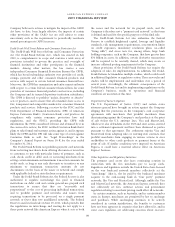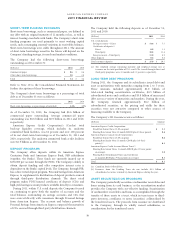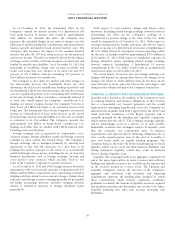American Express 2011 Annual Report Download - page 29
Download and view the complete annual report
Please find page 29 of the 2011 American Express annual report below. You can navigate through the pages in the report by either clicking on the pages listed below, or by using the keyword search tool below to find specific information within the annual report.AMERICAN EXPRESS COMPANY
2011 FINANCIAL REVIEW
surcharging by merchants. Excessive surcharging, particularly
where it disproportionately impacts American Express
cardmembers, could have a material adverse effect on the
Company if it becomes widespread. In the European Union (the
EU), the Consumer Rights Directive, which was adopted by the
EU Council of Ministers in October 2011, would prohibit
merchants from surcharging card purchases more than the
merchants’ cost of acceptance. The EU member states have two
years to adopt this legislation.
In addition to the provisions of the Dodd-Frank Reform Act
regarding merchants’ ability to offer discounts or incentives to
encourage customers’ use of a particular form of payment, a
number of U.S. states have either adopted or are considering
legislation that would prohibit card networks from imposing
similar conditions and restrictions on merchants.
Also, other countries in which the Company operates have
been considering and in some cases adopting similar legislation
and rules that would impose changes on certain practices of card
issuers, merchant acquirers and bankcard networks.
Changes to the legal and regulatory environment in which the
Company operates could have a material adverse effect on the
Company’s results of operations.
Refer to “Consolidated Capital Resources and Liquidity” for a
discussion of the series of international capital and liquidity
standards published by the Basel Committee on Banking
Supervision.
CONSOLIDATED CAPITAL RESOURCES
AND LIQUIDITY
The Company’s balance sheet management objectives are to
maintain:
폷A solid and flexible equity capital profile;
폷A broad, deep and diverse set of funding sources to finance its
assets and meet operating requirements; and
폷Liquidity programs that enable the Company to continuously
meet expected future financing obligations and business
requirements for at least a twelve-month period, even in the
event it is unable to continue to raise new funds under its
traditional funding programs.
CAPITAL STRATEGY
The Company’s objective is to retain sufficient levels of capital
generated through earnings and other sources to maintain a solid
equity capital base and to provide flexibility to support future
business growth. The Company believes capital allocated to
growing businesses with a return on risk-adjusted equity in
excess of its costs will generate shareholder value.
The level and composition of the Company’s consolidated
capital position are determined through the Company’s internal
capital adequacy assessment process, which reflects its business
activities, as well as marketplace conditions and credit rating
agency requirements. They are also influenced by subsidiary
capital requirements. The Company, as a bank holding company,
is also subject to regulatory requirements administered by the
U.S. federal banking agencies. The Federal Reserve has
established specific capital adequacy guidelines that involve
quantitative measures of assets, liabilities and certain off-balance
sheet items.
The Company currently calculates and reports its capital ratios
under the standards commonly referred to as Basel I. In June
2004, the Basel Committee on Banking Supervision (commonly
referred to as Basel) published new international guidelines for
determining regulatory capital (Basel II). In December 2007, the
U.S. bank regulatory agencies jointly adopted a final rule based
on Basel II. The Company has adopted Basel II in certain
non-U.S. jurisdictions and is currently taking steps toward Basel
II implementation in the U.S.
The Dodd-Frank Reform Act and a series of international
capital and liquidity standards known as Basel III published by
Basel on December 16, 2010 will in the future change the current
quantitative measures. In general, these changes will involve, for
the U.S. banking industry as a whole, a reduction in the types of
instruments deemed to be capital, along with an increase in the
amount of capital that assets, liabilities and certain off-balance
sheet items require. These changes will generally serve to reduce
reported capital ratios compared to current capital guidelines.
The specific U.S. guidelines supporting the new standards and
the Basel III capital standards have not been finalized, but are
generally expected to be issued in 2012. In addition to these
measurement changes, international and U.S. banking regulators
could increase the ratio levels at which banks are considered to
be “well capitalized”.
27
























